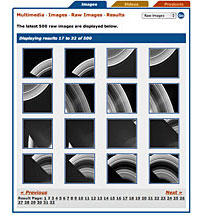Space Imagery as Art

 Editor’s note: I was doing my regular walk through raw images sent back from Saturn by Cassini. The images are organized on the webpage as thumbnails, 12 at a time. This time, something emergent appeared in my mind as I looked at several pages of thumbnails. The first thing that came to mind – instantly – was “Frank Stella“.
Editor’s note: I was doing my regular walk through raw images sent back from Saturn by Cassini. The images are organized on the webpage as thumbnails, 12 at a time. This time, something emergent appeared in my mind as I looked at several pages of thumbnails. The first thing that came to mind – instantly – was “Frank Stella“.
Now, some of you may get this instantly. Most of you will not. You see, I served time as an art major in the 70s and my brother-in-law runs a modern art museum in The Netherlands. My point? Pictures from space can be pretty and often inspirational in their own right as individual works of art. However, they can evoke unexpected responses when seen in groupings. Perhaps someone at NASA should be thinking of a travelling exhibit – an art exhibit in a large format – of images from space.
There is a precedent: NASA just took the transcendent step of producing a tactile art book of images taken by spacecraft for the blind.
 Editor’s note: Several readers brought these art activities to my attention today:
Editor’s note: Several readers brought these art activities to my attention today:
From Earth to the Universe – an exhibit of astronomical images, International Year of Astronomy
“IYA2009 is an unprecedented opportunity to present astronomy to the global community in a way that has never been done before. The “From Earth to the Universe” project is an exhibition arranged by the IYA2009 that will bring these images to a wider audience in non-traditional venues such as public parks and gardens, art museums, shopping malls and metro stations.”
Universal art – Photos from the Hubble Space Telescope show that science and beauty go hand in hand, Baltimore Sun
“Mapping the Cosmos: Images from the Hubble Space Telescope presents a vision of the universe that normally is invisible to us, in part because of the great distances involved and the obscuring effects of our atmosphere, and in part because Hubble’s unblinking eye, orbiting 350 miles above Earth’s surface, detects wavelengths of light that our eyes can’t see.”
 Reader note: This book, “Touch the Invisible Sky,” is actually just the latest in a series of books for the visually impaired (including Touch the Stars, Touch the Sun, and Touch the Universe). The author’s website has more information: http://youcandoastronomy.com. The prototype for the next book in the series, Touch the Solar System, is under development.
Reader note: This book, “Touch the Invisible Sky,” is actually just the latest in a series of books for the visually impaired (including Touch the Stars, Touch the Sun, and Touch the Universe). The author’s website has more information: http://youcandoastronomy.com. The prototype for the next book in the series, Touch the Solar System, is under development.








